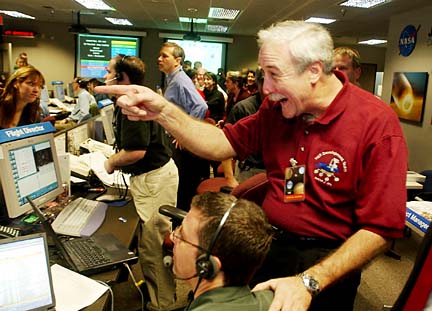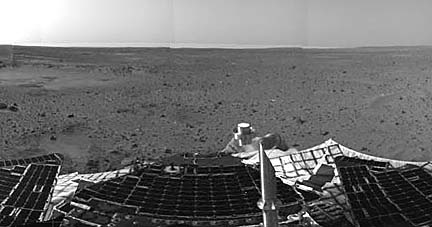
ASSOCIATED PRESS
NASA Administrator Sean O'Keefe revealed his delight last night as a signal came in from the rover Spirit on Mars. O'Keefe and the rest of the NASA team in the control room at NASA's Jet Propulsion Laboratory, in Pasadena, Calif., were jubilant with the seamless voyage.
NASA rover
bounces down
safely on MarsSpirit quickly transmits a photo
of the sundial with isle connections
PASADENA, Calif. >> A NASA rover plunged through the atmosphere of Mars and bounced down upon its rocky surface last night, beginning a mission to roam the Red Planet in search of evidence that it was once suitable for life.
Scientists at NASA's Jet Propulsion Laboratory let out whoops of joy and embraced one another as signals from the Spirit rover indicated it had survived the landing.
Within hours it began sending back photos of the Red Planet. Among the first was a tiny black and white image showing a sundial on the rover. The sundial was designed with the input of Big Island artist Jon Lomberg.
Another photo showed the Martian horizon and portions of the lander.
"This is a big night for NASA -- we are back!" NASA administrator Sean O'Keefe crowed at a celebratory news conference, relishing a success after a difficult year that included the agency's Feb. 1 Columbia space shuttle disaster.
ASSOCIATED PRESS
A view of the Martian landscape can be seen over a portion of the Mars rover "Spirit" in this panoramic view taken by the rover and sent back to Earth. The sundial that Big Island artist Jon Lomberg helped design is in the left center.
"I'm very, very proud of this team and we're on Mars. It's an absolutely incredible accomplishment," O'Keefe said. He then toasted the mission's members with champagne he said he had been saving for more than 20 years.
The spacecraft landed upright last night, which made it easy for the four-petaled lander that contains the rover to unfold, allowing it to take photographs, said Chris Jones, director of planetary flight programs at NASA's Jet Propulsion Laboratory.
"That is how we hoped it would land," Jones said.
Spirit is one of two-identical six-wheeled robots expected to roam the planet for 90 days, analyzing Martian rocks and soil for clues that could reveal whether the planet was ever a warmer, wetter place capable of sustaining life.
Mission officials said the rover won't trundle off on its own for another nine days.
The rover relied on a heat shield, parachute and rockets to slow its descent to Mars. It touched down inside Gusev Crater, a Connecticut-sized indentation just south of the Martian equator. Eight seconds before landing, a giant set of air bags inflated to cushion its bouncy landing.
"This is essentially perfect navigation. We couldn't have possibly hoped to do better than this," navigation team chief Louis D'Amario said.
Previously, about two of every three attempts to land spacecraft on Mars have failed. The latest apparent failure was the British Beagle 2 lander, which has not been heard from since it was to have set down on Mars on Christmas.
"It's an incredibly difficult place to land. Some have called it the 'death planet' for good reason," said Ed Weiler, NASA's associate administrator for space science.
NASA's last attempt at landing on Mars, in 1999, failed when a software glitch sent the Polar Lander crashing to the ground. Since then, the space agency has increased oversight of its missions.
The $820 million NASA project also includes a twin rover, Opportunity, which is set to arrive on Mars on Jan. 24.
Today, Mars is a dry and cold world. But ancient river channels and other water-carved features spied from orbit suggest that Mars may have had a more hospitable past.
"We see these intriguing hints Mars may have been a different place long ago," said Steve Squyres, the mission's main scientist.
The rovers were built to look for evidence that liquid water -- a necessary ingredient for life -- once persisted on the surface of the planet. A direct search for life on Mars is at least a decade away, NASA scientists said.
Together, the robots were launched in the most intensive scientific assault on another planetary body since the Apollo missions to the moon, said Orlando Figueroa, director of NASA's Mars exploration program.
NASA launched the 384-pound Spirit and its twin in hopes they would become the fourth and fifth U.S. spacecraft to survive landing on Mars. Twenty other spacecraft from various nations have failed.
Scientists are taking advantage of the closest approach Mars has made to Earth in 60,000 years. NASA intends to send spacecraft to Mars at regular 26-month intervals, or each time the Earth laps the Red Planet as they both circle the sun.
For more information on the sundial, visit athena.cornell.edu/kids/sundial.html. To learn more about the Mars mission, see marsrovers.jpl.nasa.gov/home/index.html.

